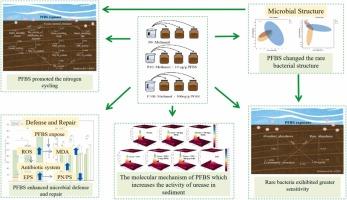Effects of Perfluorobutanesulfonic acid (PFBS) on the sediment microbial communities, and the interaction mechanism with urease and extracellular polymeric substances (EPS)
IF 11.3
1区 环境科学与生态学
Q1 ENGINEERING, ENVIRONMENTAL
引用次数: 0
Abstract
The influence of perfluorobutane sulphonic acid (PFBS) on sediment microbial communities and nitrogen cycling was systematically investigated in this study. After 28 d of PFBS, the diversity of sediment microorganisms was inhibited, with rare bacterial community demonstrating stronger structural decisive role than abundant taxa. Meanwhile, PFBS induced the secretion of extracellular polymeric substances (EPS), causing elevated reactive oxygen species levels and triggering antioxidant defences. EPS could also act as a barrier between PFBS and urease to reduce the toxicity of PFBS to urease. In the PFBS-urease-EPS system, ultraviolet-visible spectroscopy revealed intensified absorption peaks corresponding to π→π* transitions in peptide backbone structures, indicating that there was an interaction between urease and EPS, a change in the structure of the urease backbone. And the increase in α-helix content indicated that the secondary structure of urease becomes more compact and improves urease activity, which subsequently facilitated ammonium nitrogen (NH4+-N) production in sediments. Partial Least Squares Path Models (PLS-PM) indicated that PFBS stress directly altered the abundance of nitrogen-cycling bacteria, upregulated genes encoding enzymes, and increased the activities of key enzymes of nitrogen-cycling processes, thereby promoting nitrogen cycling.

全氟丁烷磺酸(PFBS)对沉积物微生物群落的影响及其与脲酶和胞外聚合物(EPS)的相互作用机制
本研究系统研究了全氟丁烷磺酸(PFBS)对沉积物微生物群落和氮循环的影响。PFBS处理28 d后,沉积物微生物多样性受到抑制,较少的细菌群落比丰富的类群表现出更强的结构决定性作用。同时,PFBS诱导细胞外聚合物质(EPS)的分泌,导致活性氧水平升高,触发抗氧化防御。EPS还可以作为PFBS与脲酶之间的屏障,降低PFBS对脲酶的毒性。在pfbs -脲酶-EPS体系中,紫外可见光谱显示肽骨架结构中π→π*跃迁对应的吸收峰增强,表明脲酶与EPS发生了相互作用,脲酶骨架结构发生了变化。α-螺旋含量的增加表明脲酶二级结构更加致密,脲酶活性提高,从而促进了沉积物中铵态氮(NH4+-N)的生成。偏最小二乘路径模型(PLS-PM)表明,PFBS胁迫直接改变了氮循环细菌的丰度,上调了编码酶的基因,增加了氮循环过程中关键酶的活性,从而促进了氮循环。
本文章由计算机程序翻译,如有差异,请以英文原文为准。
求助全文
约1分钟内获得全文
求助全文
来源期刊

Journal of Hazardous Materials
工程技术-工程:环境
CiteScore
25.40
自引率
5.90%
发文量
3059
审稿时长
58 days
期刊介绍:
The Journal of Hazardous Materials serves as a global platform for promoting cutting-edge research in the field of Environmental Science and Engineering. Our publication features a wide range of articles, including full-length research papers, review articles, and perspectives, with the aim of enhancing our understanding of the dangers and risks associated with various materials concerning public health and the environment. It is important to note that the term "environmental contaminants" refers specifically to substances that pose hazardous effects through contamination, while excluding those that do not have such impacts on the environment or human health. Moreover, we emphasize the distinction between wastes and hazardous materials in order to provide further clarity on the scope of the journal. We have a keen interest in exploring specific compounds and microbial agents that have adverse effects on the environment.
 求助内容:
求助内容: 应助结果提醒方式:
应助结果提醒方式:


